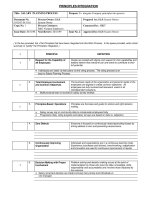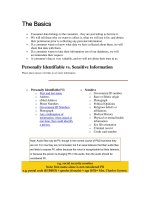Tài liệu Branding Yourself docx
Bạn đang xem bản rút gọn của tài liệu. Xem và tải ngay bản đầy đủ của tài liệu tại đây (19.27 MB, 399 trang )
ptg8286219
ptg8286219
Branding Yourself
How to Use Social Media to Invent or
Reinvent Yourself, Second Edition
Erik DEckErs
kylE lacy
ptg8286219
Branding Yourself: How to Use Social
Media to Invent or Reinvent Yourself,
Second Edition
Copyright © 2013 by Pearson Education, Inc.
All rights reserved. No part of this book shall be reproduced, stored in
a retrieval system, or transmitted by any means, electronic, mechanical,
photocopying, recording, or otherwise, without written permission from
the publisher. No patent liability is assumed with respect to the use of
the information contained herein. Although every precaution has been
taken in the preparation of this book, the publisher and author assume
no responsibility for errors or omissions. Nor is any liability assumed for
damages resulting from the use of the information contained herein.
ISBN-13: 978-0-7897-4972-7
ISBN-10: 0-7897-4972-6
Library of Congress Cataloging-in-Publication Data is on file.
Printed in the United States of America
First Printing: July 2012
Trademarks
All terms mentioned in this book that are known to be trademarks or
service marks have been appropriately capitalized. Que Publishing can-
not attest to the accuracy of this information. Use of a term in this book
should not be regarded as affecting the validity of any trademark or ser-
vice mark.
The double C in a circle, the words and logotype “Creative Commons”
and the Creative Commons license buttons reproduced
in this publication are trademarks of Creative Commons. For
more information about Creative Commons, visit
/>Warning and Disclaimer
Every effort has been made to make this book as complete and as accurate
as possible, but no warranty or fitness is implied. The information pro-
vided is on an “as is” basis. The authors and the publisher shall have nei-
ther liability nor responsibility to any person or entity with respect to any
loss or damages arising from the information contained in this book.
Bulk Sales
Que Publishing offers excellent discounts on this book when ordered in
quantity for bulk purchases or special sales. For more information, please
contact
U.S. Corporate and Government Sales
1-800-382-3419
For sales outside of the U.S., please contact
International Sales
Editor-in-Chief
Greg Wiegand
Senior Acquisitions Editor
Katherine Bull
Development Editor
Romny French
Managing Editor
Kristy Hart
Project Editor
Andrew Beaster
Copy Editor
Apostrophe Editing
Services
Indexer
Cheryl Lenser
Proofreader
Sarah Kearns
Technical Editor
Pierre DeBois,
Zimana, LLC
Publishing Coordinator
Cindy Teeters
Romny French
Book Designer
Anne Jones
Compositor
Nonie Ratcliff
Que Biz-Tech Editorial
Board
Michael Brito
Jason Falls
Rebecca Lieb
Simon Salt
Peter Shankman
ptg8286219
Table of ConTenTs
I WHY DO I CARE ABOUT SELF-PROMOTION? 1
1 Welcome to the Party 3
What Is Self-Promotion? 5
Why Is Self-Promotion Important? 5
What Self-Promotion Is Not 6
What Can Self-Promotion Do for You and
Your Career? 6
Personal Branding 6
What Is Personal Branding? 7
Go Brand Yourself 7
How to Build Your Brand 8
The Five Universal Objectives of Personal Branding 10
Discover Your Passion. (Passion Is Fundamental to
Achieving Your Goals.) 10
Be Bold. (It’s Okay to Talk About Yourself.) 11
Tell Your Story. (Your Story Is What Makes
You Special.) 13
Create Relationships. (Relationships Lead to
Opportunities.) 14
Take Action. (Even a Small Step Is a Step Forward.). . . . . 15
Who Needs Self-Promotion? 16
Meet Our Heroes 18
2 How Do You Fit in the Mix? 21
The Basics of Building Your Personal Brand Story 23
Writing Your Personal Brand Autobiography 23
Prioritizing When Writing Your Personal Brand
Story 24
Writing Your Personal Brand Biography 25
How Do Our Heroes Use the Personal Brand
Biography? 27
ptg8286219
Branding Yourself
iiivvv
Telling Your Complete Brand Story 30
The Law of Anecdotal Value 32
Surround Yourself with People Who Have Passion 33
Sharing Memories and Stories 33
Do’s and Don’ts of Telling Your Story 34
1. Don’t Post Pictures That Would Shock Your Mother 35
2. Don’t View Your Personal Brand Story as a Sales Pitch 35
3. Don’t Post Something You Will Regret Later 35
4. Don’t Ask for Things First. Ask for Things Second 36
5. Don’t Get Distracted 36
6. Don’t Underestimate the Power of Your Network 36
7. Do Invest in Yourself 37
8. Do Invest in Other People 37
9. Do Be Visible and Active 37
10. Do Take Some Time for Yourself 37
II YOUR NETWORK IS YOUR CASTLE—BUILD IT 39
3 Blogging: Telling Your Story 41
What Is Blogging? 43
A Clarification of Terms 45
Why Should You Blog? 45
Choose Your Blogging Platforms 47
Blogspot.com/Blogger.com 48
WordPress.com and WordPress.org 49
Other Blogging Platforms 50
Tumblr 52
Which Platform Should You Choose? 54
Setting Up a Blog 54
Purchasing and Hosting a Domain Name 56
Getting Inspired 57
What Should You Write About? 57
Finding Subject Matter 60
How to Write a Blog Post 60
Writing for Readers Versus Writing for Search Engines 62
It’s About the Quality of the Writing 62
ptg8286219
v
Contents
Google Expects You to Write Good Stuff 63
How Often Should You Post? 64
How Long Should Your Posts Be? 65
But My Posts Are Too Long 66
SEO Through Blogging. . . . . . . . . . . . . . . . . . . . . . . . . . . . . . . . . . . . . . . . . 66
How Does This Apply to Our Four Heroes? 69
Do’s and Don’ts of Blogging 70
Do’s 70
Don’ts 71
A Final Note on the “Rules” of Blogging. . . . . . . . . . . . . . . . . . . . . . 72
4 LinkedIn: Networking on Steroids 73
The Basics of LinkedIn 75
What’s in a LinkedIn Profile? 75
The Employment Section 75
Your Photo/Avatar 77
The Education Section. . . . . . . . . . . . . . . . . . . . . . . . . . . . . . . . . . . . . . 77
The Summary 77
Your Websites 78
Cool LinkedIn Features Worth Examining 79
Creating Contacts on LinkedIn 81
Using Your Email Database 82
Other Ways to Connect: Colleagues and Classmates 83
Building Off Your Second- and Third-Degree Network . 84
Transforming Your Contacts into Connections 85
The Importance of Recommendations 87
Ten Do’s and Don’ts of LinkedIn 90
1. Do Upload a Professional Picture 90
2. Do Connect to Your Real Friends and Contacts 91
3. Do Keep Your Profile Current 91
4. Do Delete People Who Spam You 91
5. Do Spend Some Time on Your Summary 92
6. Don’t Use LinkedIn Like Facebook and Twitter 92
7. Don’t Sync LinkedIn with Twitter 92
8. Don’t Decline Invitations. Archive Them. . . . . . . . . . . . . 92
ptg8286219
Branding Yourself
vvviii
9. Don’t Ask Everyone for Recommendations 93
10. Don’t Forget to Use Spelling and
Grammar Check 93
5 Twitter: Sharing in the Conversation 95
Why Should You Use Twitter? 96
What Can Twitter Do for You? 97
How Do You Use Twitter? 99
Creating a Twitter Profile 99
Getting Followers 100
Sending Out Tweets 101
Retweeting Your Content 102
Applications for Twitter Domination 104
Desktop Applications 106
Web-Based Applications 107
Mobile Applications 109
What Should You Tweet (and What Shouldn’t You?) 110
Personal Branding Case Study : @applegirl 113
Do’s and Don’ts While Using Twitter 113
Twitter Tips in 140 Characters or Less 114
How Does This Chapter Apply to Our Four Heroes? 115
6 Facebook: Developing a Community of Friends 117
Why Should You Use Facebook? 118
What Can Facebook Do for You? 120
Reconnect with Old Classmates and Co-Workers 120
Use a Facebook Page to Professionally
Brand Yourself 120
Help a Cause and Be Philanthropic 121
Find and Attend Local Events 121
What You Should Know First About Facebook 122
Professional Page and Personal Profile 123
The Basics: Creating a Personal Profile 124
Staying in Control of Your Profile 127
ptg8286219
vii
Contents
Working with Your Personal Page Privacy Settings 127
Setting Up Your Privacy Settings for Your Personal
Account 127
Working with Your Customized URL 129
How Can I Use a Professional Page for Personal
Branding? 130
Using Insights to Track Your Content Growth 133
Setting Up Your Professional Page 134
Top Six Tips for Using Facebook 135
Ten Do’s and Don’ts of Facebook 136
1. Do Upload a Real Picture. 136
2. Do Share Industry-Specific Content. 138
3. Do Use Your Email to Find Friends. 138
4. Do Read the Terms of Service. 138
5. Don’t Use Inappropriate Language. 138
6. Don’t Spam People. 139
7. Don’t Poke People. 139
8. Don’t Tag Everyone in a Picture. 139
9. Don’t Sync Your Twitter Profile with Your
Facebook Page 139
10. Don’t Invite People to Your Professional Page
Over and Over and Over. 140
Facebook Tips in 140 Characters or Less 140
7 Say Cheese: Sharing Photos and Videos 143
Why Video 144
Where to Put Your Video 146
YouTube 146
Vimeo 147
Flickr 148
Shooting Video 149
Video Do’s and Don’ts 150
Recording Screen Capture Videos 151
Case Study: Gary Vaynerchuk 151
What Should I Make Videos Of? 152
ptg8286219
Branding Yourself
viii
Why Photos 153
Where to Post Your Photos 153
Picasa 153
Flickr 154
Photobucket 154
Instagram 154
Facebook. . . . . . . . . . . . . . . . . . . . . . . . . . . . . . . . . . . . . . . . . . . . . . . . . . . . 155
Copyright: Permission, Creative Commons, and
Licensing 156
Creative Commons 156
Embedding Videos and Photos in Your Blog 158
Adding Photos 158
Adding Videos 160
SEO for Videos and Photos 161
YouTube SEO 162
Photo SEO 163
The Video Resume 165
A Cautionary Note About Video Resumes 167
Photos and Video Tips in 140 Characters 168
8 Other Social Networking Tools 169
Google+ 170
BranchOut 172
Twylah 174
Pinterest 176
Quora 180
How Does This Apply to Our Four Heroes? 181
9 Googling Yourself: Finding Yourself on
Search Engines 183
Have You Ever Googled Yourself? 184
What Do You Want Others to Find? 186
Search Engine Optimization 187
What SEO USED to Be 188
Keywords 188
Titles 188
ptg8286219
ix
Contents
Body Copy 189
Anchor Text 189
Backlinks 190
What SEO Looks at Now 190
Time on Site 191
Bounce Rate 191
Click-Through Rate 191
Page Load Speed 192
How Can You Influence These Factors? 193
Quality of Content 193
Quality of Design 194
Ease of Navigation 195
A Quick Note About Backlinks 196
Video 196
Personal Connections/Social Media 197
Reverse Search Engine Optimization 198
What if You Share a Common Name? 199
Search Engine Tools 201
Google Alerts 201
Google Image Search 202
Google Blog Search 202
Bing 203
Yahoo! 204
Other Search Engines 205
The Value of Reputation Management 206
Reputation Management Tools 207
BrandYourself.com 207
Reputation.com 207
Google’s Me on the Web 209
How Do Our Heroes Use SEO? 210
Reputation Management Tips in 140 Characters 210
10 Bringing It All Together: Launching Your Brand 213
What Is a Personal Brand Campaign? 215
How Do Our Heroes Build Their P&T Statement? 217
Why Is a Personal Brand Campaign Important? 220
ptg8286219
Branding Yourself
x
Building Your Personal Brand Campaign 221
Developing Your Personal Brand Campaign 221
Implementing Your Personal Brand Campaign 223
Automating Your Personal Brand Campaign 224
Unique Ways to Launch Your Branding Campaign 225
How Should Our Heroes Launch Their Brands? 228
Do’s and Don’ts of Launching Your Personal Brand 229
11 Measuring Success: You Like Me, You Really
Like Me! . . . . . . . . . . . . . . . . . . . . . . . . . . . . . . . . . . . . . . . . . . . . . . . . . . . . . . . . . . . . . 231
Why Should You Measure 232
What Should You Measure? 233
Reach 233
Quality Versus Quantity. . . . . . . . . . . . . . . . . . . . . . . . . . . . . . . . . . . 234
Visibility 234
Influence 235
Measuring Influence 235
How Should You Measure? 238
Measuring Your Blogging Effectiveness 238
Using Google Analytics for Your Blog 240
Setting Up a Google Analytics Account 241
Installing Google Analytics. . . . . . . . . . . . . . . . . . . . . . . . . . . . . . . . 242
Getting an Overview of Your Website Performance 242
Measuring Your Twitter Effectiveness 243
Other Total Influence Measurement Tools 245
Measuring Your LinkedIn Effectiveness 246
Measuring Your Facebook Effectiveness 248
Measuring Your YouTube Effectiveness 250
Nine Tools to Use for Measurement 252
Effectively Measuring Your Personal Brand 254
How Can Our Heroes Use Analytics and Measurement? 255
Do’s and Don’ts for Analytics and Measurement 256
Analytics Tips in 140 Characters 256
ptg8286219
xi
Contents
II PROMOTING YOUR BRAND IN THE REAL WORLD 259
12 How to Network: Hello, My Name Is 261
Why Should I Bother Networking? 263
A Networking Case Study: Starla West 264
The Rules of Networking 265
It’s Not About You 265
Giver’s Gain Is Not Quid Pro Quo 266
Be Honest Online and Offline 269
You’re Just as Good as Everyone Else 270
Avoid People Who Are Unhelpful 271
Network with Your Competition 271
Three Types of Networking 273
Networking Groups. . . . . . . . . . . . . . . . . . . . . . . . . . . . . . . . . . . . . . . . 273
Meeting People 274
The Networking “Dance” 274
What Should You Say? 275
Networking Faux Pas 276
The Follow-Up 278
One-on-One Networking 278
How to Set Up the One-On-One Networking
Meeting. . . . . . . . . . . . . . . . . . . . . . . . . . . . . . . . . . . . . . . . . . . . . . . . . . 279
What to Talk About During Your One-On-One 280
No One Wants a Sales Pitch 281
The “Pick-Your-Brain” Meeting 281
The Follow-Up 284
Forwarding Articles and Links 284
Sharing Opportunities 285
Making Connections and Introductions for Others 285
But I Just Don’t Want to Meet the Other Person. . . . . . . . 286
Be Honest 286
But What if the Other Person Isn’t Honest? 287
Do’s and Don’ts of Networking 288
Do 288
Don’t 289
How Would Our Heroes Network? 289
ptg8286219
Branding Yourself
xii
13 Public Speaking: We Promise You Won’t Die 291
Case Study: Hazel Walker, The Queen of Networking 293
Should I Speak in Public? 294
No, Seriously. 294
But I Hate Speaking in Public 294
Overcoming Your Fear of Public Speaking 295
Toastmasters 295
Classes at Your Local College or University 296
Seminars and Courses 296
Speakers Associations 297
Private or Executive Coaches 297
Finding or Creating Your Own Speaking Niche 297
How to Start Your Speaking Career 299
Identify Speaking Opportunities 301
Industry Groups 302
Civic Groups 303
Conferences, Trade Shows, and Expos 304
Introducing Yourself 305
Promoting Your Talk 306
How Does This Apply to Our Four Heroes? 309
Giving Your Talk 310
Important Technology Tips for Presenters 311
Miscellaneous Tips, 140 Characters or Less 316
14 Getting Published: I’m an Author! 319
Why Should I Become a Writer? 322
Publication Opportunities 323
Local Newspapers 324
Business Newspapers 325
Scientific Journals 326
Specialty Magazines and Newspapers 327
Hobby Publications 328
Major Mainstream Magazines 329
Go Horizontal Instead of Vertical 329
ptg8286219
xiii
Contents
Build Your Personal Brand with Your Writing 330
Publication Rights 331
Create Your Own Articles’ Niche 332
Getting Started 334
Getting Paid 336
Paying Your Dues 337
The Myth of “Exposure” 338
Do’s and Don’ts of Writing for Publication 338
How Can Our Heroes Turn to Writing for Publication? 340
15 Personal Branding: Using What You’ve Learned
to Land Your Dream Job 343
Using Your Network to Find a Job 347
Twitter: Make Job Connections in 140 Characters 347
Use LinkedIn to Make Job Connections 348
The Art of the Connection 348
Should You Connect Directly or Ask for a
Connection? 350
Use LinkedIn to Get Inside Info 351
Creating a Résumé 352
Should I Create a Paper Résumé? 352
How Does Social Media Fit in Your Résumé? 353
Six Tips for Listing Social Media on Your Résumé 354
Do’s and Don’ts of Résumé Building. . . . . . . . . . . . . . . . . . . . . . . . . 355
Don’t Rely on the Job Boards 358
Try the Company Job Boards Instead 359
Use LinkedIn to Bypass the Job Board Process 361
Skip HR Altogether, and Work Your Network 361
Using Your Network to Land a Freelance Contract 362
How Can Our Heroes Find a Job Through
Networking? 363
A Social Media Case Study 364
Another Social Media Case Study 367
Job Searching Tips in 140 Characters 368
Index 369
ptg8286219
About the Authors
Erik Deckers is the co-owner and vice president of creative services of Professional
Blog Service, a ghost blogging and social media agency. He has been blogging since
1997 and speaks widely on social media topics. He is also a newspaper columnist
and award-winning playwright. Erik coauthored No Bullshit Social Media: The All-
Business, No-Hype Guide to Social Media Marketing with Jason Falls.
Kyle Lacy is a principal of Marketing Research and Education for ExactTarget,
a leading global provider of interactive marketing solutions. He has an in-depth
understanding of the application of social and interactive media for both small and
large businesses and regularly speaks on topics ranging from social media adop-
tion to interactive marketing trends across email, mobile, and social media. Kyle
has been recognized as one of Indiana’s 40-under-40 by the Indianapolis Business
Journal, Anderson University’s Young Alumni of the Year, and TechPoint’s Young
Professional of the Year. Learn more about Kyle at KyleLacy.com.
Deckers and Lacy coauthored the first edition of Branding Yourself.
Dedication
Erik
To Toni, Madison, Emmalie, and Benjamin.
Kyle
To my family and wife, Rachel.
Acknowledgments
We often say that social media is a community, and this book is no different. We
couldn’t have done it without some very special people.
The words “thank you” don’t do justice to our appreciation for your help. First,
thank you to Katherine Bull, our acquisitions editor at Pearson, for taking a chance
on us a second time. Thanks also to Brandon Prebynski, Leslie O’Neill, Karen Gill,
and Jovana Shirley for the first edition of this book. And thanks to Pierre DeBois of
Zimana, LLC, Andrew Beaster, San Dee Phillips, and Romny French for their out-
standing work on making the second edition even better.
We also want to thank the people in our lives and our community who helped us
gain the knowledge, experience, and insights to produce this book. We appreciate
everything you have ever done for us. So thank you, in no particular order,
Paul Lorinczi, Brandon Coon, the wonderful people that make up ExactTarget,
Lorraine Ball, Hazel Walker, Douglas Karr, Jason Falls, Tony Scelzo, Noah Coffey,
ptg8286219
Shawn Plew, the whole Lacy clan of Dan, Rainy, Kayla, Zach and Kelly,
Lindsay Manfredi, Jay Baer, Sarah Robbins, Mike Seidle, and Scott Wise.
Erik would also like to thank Kyle for asking him to help with his first writing
project, which led to this one, and hopefully will lead to many more.
Erik would like to give a special thanks to his wife Toni and his three children,
Maddie, Emma, and Ben, for giving him the support and love to write this book.
Hopefully those 2:00 a.m. bedtimes will pay off. Kyle would like to especially thank
his wife Rachel for being okay with the late nights and working weekends.
ptg8286219
We Want to Hear from You!
As the reader of this book, you are our most important critic and commentator.
We value your opinion and want to know what we’re doing right, what we could
do better, what areas you’d like to see us publish in, and any other words of wis-
dom you’re willing to pass our way.
We welcome your comments. You can email or write to let us know what you did
or didn’t like about this book—as well as what we can do to make our books better.
Please note that we cannot help you with technical problems related to the topic of
this book.
When you write, please be sure to include this book’s title and author as well as
your name and email address. We will carefully review your comments and share
them with the author and editors who worked on the book.
Email:
Mail: Que Publishing ATTN: Reader Feedback
800 East 96th Street
Indianapolis, IN 46240 USA
Reader Services
Visit our website and register this book at quepublishing.com/register for conve-
nient access to any updates, downloads, or errata that might be available for this
book.
ptg8286219
I
Why Do I Care About
Self-Promotion?
1 Welcome to the Party 3
2 How Do You Fit in the Mix? 21
ptg8286219
TTThhhiiisss pppaaagggeee iiinnnttteeennntttiiiooonnnaaallllllyyy llleeefffttt bbblllaaannnkkk
ptg8286219
1
Welcome to the Party
A story.
When Erik Deckers moved to Indianapolis in 2006, he
knew one person. When an expected job didn’t quite
work out, he searched for another, relying on job boards.
He finally found a job at the Indiana State Department of
Health.
Erik worked there for nearly 16 months and got to know a
number of people in the agency and a few people in other
agencies. Rarely, however, did he ever have the opportu-
nity to work with people on the outside. Consorting with
the private sector was almost frowned upon, and attend-
ing business-related events during work hours was not
allowed. Needless to say, Erik’s professional circle was
limited to his co-workers and a few journalists around
the state.
When Erik left for a private sector job in 2007, selling
direct mail services (interestingly, he got this job through
the one guy he knew when he moved to Indianapolis), he
realized the people he knew in his old job weren’t going
to help him in his new efforts, at least not right away.
ptg8286219
Part I Why Do I Care About Self-Promotion?
4
So, rather than spending every day on the phone, Erik
started attending Rainmakers meetings (a local net-
working organization), a business book club, and the
Chambers of Commerce in Indianapolis and Fishers, a
suburb to the northeast. He attended at least two and
sometimes three events a week, at 7:30 in the morning or
5:00 in the afternoon. The idea was that by meeting other
people in the business world, he could learn about new
opportunities, meet possible new clients, and find new
partners who can act as evangelists, a sort of “freelance
salesperson” to their clients.
At the same time, he attended a half-day seminar on
social media and blogging put on by a local Internet
marketing company. Erik had been blogging infrequently
up until that point, but he began to take it seriously. He
studied blogging by reading other blogs and books about
blogging and trying some of the new ideas and tech-
niques he was learning.
As part of his networking, Erik would have coffee or lunch
with people he met. He tried to learn as much about them
as he could and asked if they could refer him to anyone
else who would be interested in learning about his ser-
vices. Many times, they asked about blogging and social
media, and he would tell them as much as he could. He
spent a lot of time online, blogging, promoting his blog,
and communicating on Facebook, LinkedIn, and Smaller
Indiana, a niche social network.
Those connections have led to many opportunities—
sales, speaking opportunities, blogging opportunities, a
job, and even this book—that never would have hap-
pened if Erik had limited his job search to just the job
ptg8286219
5
Chapter 1 Welcome to the Party
boards—and especially if he hadn’t drunk enough coffee
to float a battleship.
When Kyle and Erik were discussing how to write this
book, Kyle said, “We need to write it for you, the you from
2007. We need to tell that guy how to brand himself and
promote himself online.”
What Is Self-Promotion?
Self-promotion is just what it sounds like: promoting yourself, your events, your
accomplishments, your victories, and even your defeats, problems, and lessons you
have learned. You do it so you can increase your visibility to and awareness by oth-
ers, increase traffic to your website, increase sales, and get more speaking opportu-
nities, exhibitions, and gigs—more of whatever it is you’re looking for.
You promote yourself so you can get even more opportunities, which you can then
tell people about.
Self-promotion is also called branding yourself, because that’s actually what it has
become. (That, and it’s what we wanted to call the book.) We prefer to think of
it as personal branding because you need to think of yourself as a brand, just like
Coca-Cola, McDonald’s, Google, or Facebook.
Why Is Self-Promotion Important?
You can’t count on people calling you out of the blue to hire you, buy your service,
or book you for an event if they don’t know about you. The only way to get people
to know who you are and what you do is to tell them. And you want to tell as
many people as you can who are actually interested.
Self-promotion can help you make those important connections that will further
your career and improve your professional standing. It can be as simple as intro-
ducing yourself to the organizer of a conference and telling her you are interested
in speaking at her next conference, or it can be as involved as writing a book or
two and then spending a day emailing every conference organizer you can to get as
many speaking deals as you can.
@kyleplacy:
Is that a shot at me?
@edeckers:
No, not at all, Mr. I-Don’t-Have-Time-for-Lunch-
Today.
ptg8286219
Part I Why Do I Care About Self-Promotion?
6
What Self-Promotion Is Not
Self-promotion is not bragging or boasting. It’s not being something bigger than
you are. It’s just letting people know who you are and what you do.
It’s perfectly acceptable to promote yourself without looking like an arrogant jerk.
People are going to be out promoting themselves and their personal endeavors and
small businesses. If you’re not, you’re missing good opportunities, and others are
going to beat you in the competition. They’re going to sell their art, get their speak-
ing gigs, get more web traffic, or whatever they’re competing with you for.
What Can Self-Promotion Do for You and Your Career?
Without question, self-promotion can make you successful. And if you’re already
successful, it can make your personal brand huge. You don’t get to be a success
without knowing a lot of people and having a lot of people know you. If you want
to be stuck in a little, gray cubicle for your entire career, never rising above lower
middle management, keep your head down and don’t attract attention. Actually,
put this book down. Stop reading! But if you want to make a name for yourself,
establish a good reputation, finally get that corner office, or even own your own
successful business, you need to promote yourself.
To do that, you need to be passionate about two things: the work you do and your-
self. If you’re not passionate about what you do, find the thing you’re passionate
about. If you’re not passionate about yourself, seek professional help. The person
you should love the most, admire the most, and treasure the most is you. And
when you have that confidence in yourself, others see it, too. When you share that
confidence with other people, they feel confident about you as well.
So don’t sit in your cubicle any longer. Figure out what you want to do, make it
happen, and then start telling people about it. Let them know that you are good at
what you do. Let them come to you for answers and information.
Personal Branding
If you ask 100 people what personal branding is, you’ll get 100 different answers.
But the answer we’re going with is that it is an emotional response to the image or
name of a particular company, product, or person.
Think of some corporate brands you have positive or negative feelings toward:
McDonald’s, Starbucks, Coca-Cola, Wal-Mart, Indianapolis Colts, Chicago Cubs,
BP. These brands are popular because they have created a lot of positive feelings in
their fans, even if they also engender negative feelings in their detractors.
ptg8286219
7
Chapter 1 Welcome to the Party
Similarly, people have emotional responses when they see you or meet you for
the first time. These responses can be feelings of joy, pleasure, love, dread, fear, or
anger. When they hear your name again, they will either have new experiences and
emotions, or they will relive the old ones. The kinds of emotional responses they
have depend on you.
Note
A brand is an emotional response to the image or name of a particular
company, product, or person.
What Is Personal Branding?
Branding yourself means that you create the right kind of emotional response you
want people to have when they hear your name, see you online, or meet you in real
life.
The “right” kind doesn’t mean being someone you’re not. It’s your personality,
your voice, your interests, your habits—everything about you that you want people
to know. This means that the information you show to other people, the things
you say, and the photos you post should all fit within that theme of your personal
brand.
If you’re a stand-up comic, your brand is “funny.” You want people to see that you
actually are funny, which means posting some of your jokes and posting links to
videos of your routine and even to your blog.
If you’re a freelance graphic designer, your brand is “creative.” You want people to
know you have creative skills, so you’ll show people samples of your work through
an online portfolio, possibly a blog.
If you’re a cost reduction analyst, your brand is “saving companies’ money.” You
can demonstrate your knowledge by answering questions on LinkedIn, writing
useful articles on your blog, and giving talks to Chambers of Commerce.
Go Brand Yourself
Ask yourself: What do I want to be known for? What qualities do I want people to
associate with me? What is the first thing I want to have pop in their heads when
they hear my name?
Next, create a list of those qualities. Write down everything you can think of in five
minutes, even if you think you’re repeating yourself. Don’t edit yourself, and don’t
leave anything off. This is not a time to be humble or to think, “No one will think
ptg8286219
Part I Why Do I Care About Self-Promotion?
8
of me that way.” Come up with every adjective and noun you can think of, no mat-
ter how far out or weird it may seem. It may just spur another idea that actually
does fit.
Let’s say your list looks like this:
Creative Funny Interested in people
Musical Well-read Detail-oriented
Networker Outgoing Singer
Knowledgeable Songwriter Teacher
Intelligent Dedicated Organized
From here, you need to start grouping things that are similar. In one group, we
have musical, songwriter, singer, and creative. In another, we have knowledgeable,
intelligent, well-read, and teacher. In a third, we have networker, outgoing, and
interested in people.
You can call these groups anything you want, but let’s stick with Musical,
Knowledgeable, and Networker. These groups are the start of branding yourself.
They’re the areas you should concentrate on being known for—the areas that can
define what people know you for. They may know you for more—being a good
cook, a budding actor, someone who’s fun to hang out with at parties—but those
are reserved more for your personal friends, not something you want to focus
on, at least not at the moment. These latter attributes can be an additional side to
your brand once in a while, but they shouldn’t be the main focus of your personal
brand.
How to Build Your Brand
The remaining 14 chapters of this book focus on how to build your brand. You’re
going to learn what you need to do to promote your personal brand with each of
the social media tools and real-world events discussed, whether it’s writing a blog
post, posting messages on Twitter, or giving a speech.
Before you start, however, you need to understand the foundation of personal
branding.









